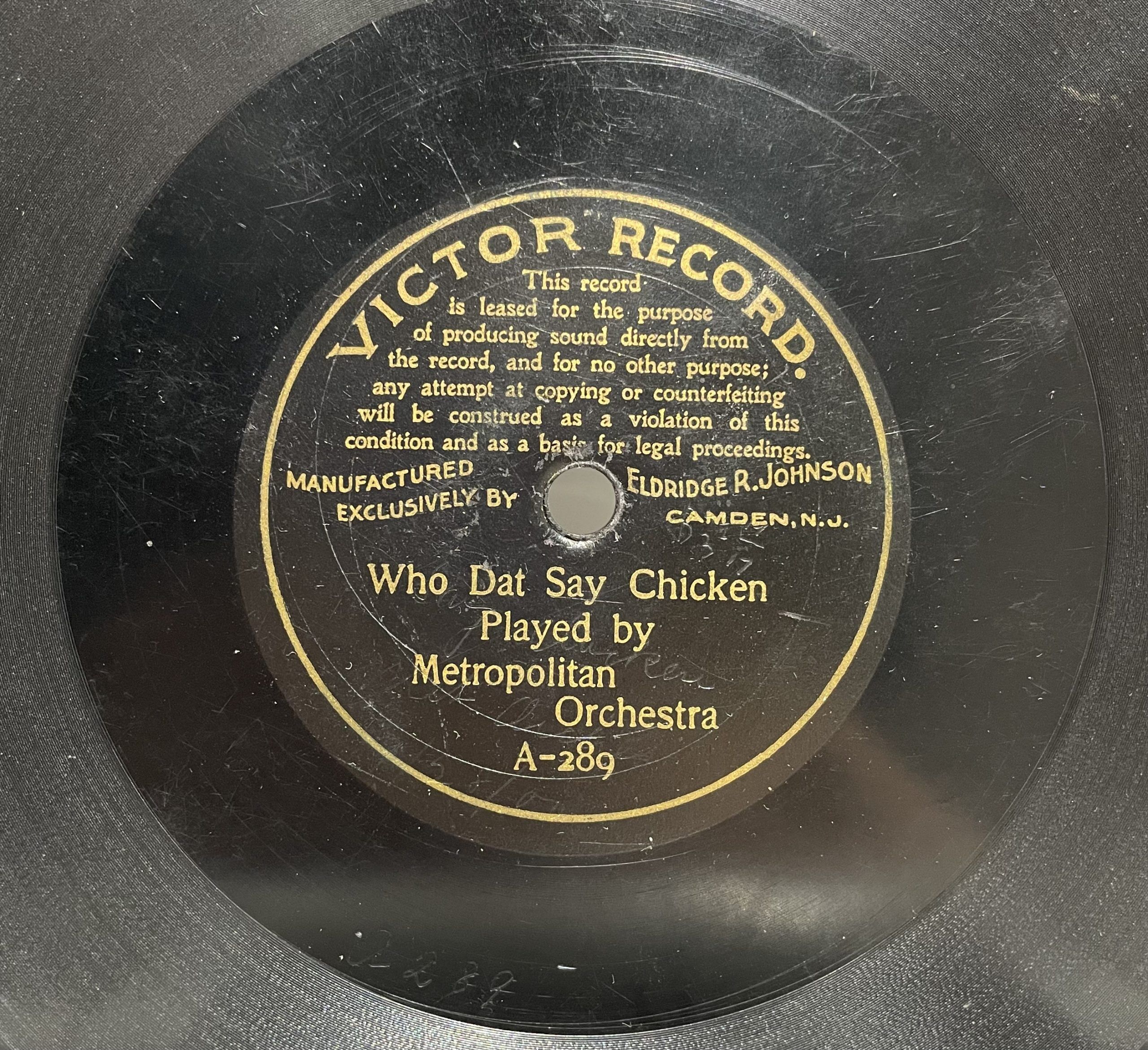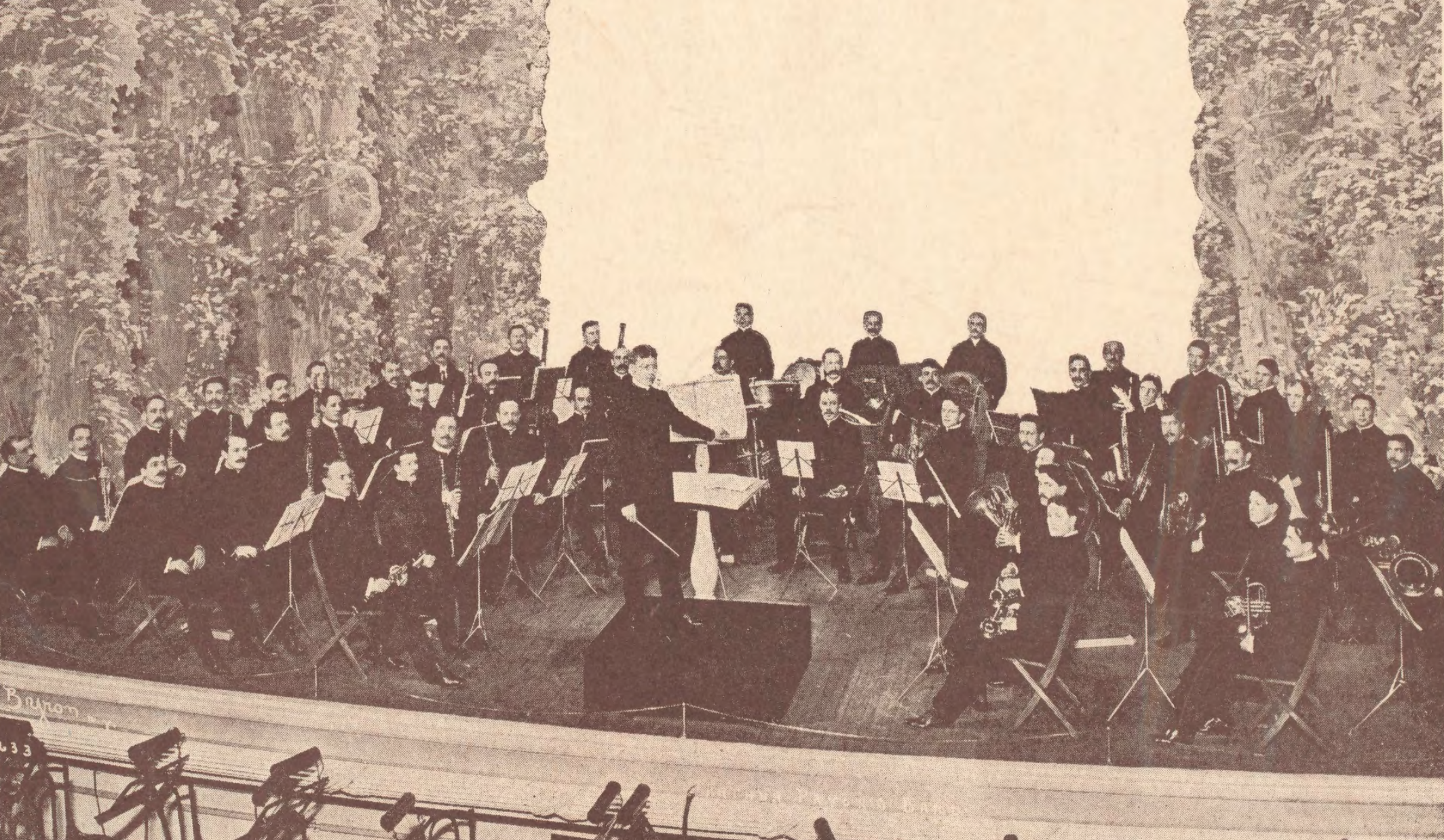Since the introduction of the phonograph, syncopated music was commonly recorded. But often while flipping through collections of classic ragtime sheet music, it seems odd that many of the rags that are regularly played today didn’t seem to be recorded in their time. There are quite a few explanations as to why this is. Even so, it can be surprising how much rare ragtime was recorded. The phonograph business was still very new and experimental, so what exactly was decided upon to be recorded was still up in the air. Vocal syncopated music was everywhere in the record world, but the instrumental sort was generally neglected. Generally people bought vocal records more than instrumental, as military bands were everywhere. Even if ragtime was the “forbidden” music of its day, plenty of bandmasters recorded some rare and generally unpopular rags.
Issler’s Orchestra could easily be credited with recording the first instrumental ragtime. Edward Issler took the initiative to record plenty of syncopated dance numbers, long before the term “ragtime” was used among polite white society. Issler began recording in 1888, and as early as the next year he was recording all sorts of obscure polkas and “negro dances” as they were called at the time. One of the most popular of these instrumental numbers was “Patrol Comique.”
Originally written by an Englishman, Thomas Hindley, in 1886, “Patrol Comique” gained popularity with the fringe phonograph crowd from the beginning. By the middle 1890s, the piece had been recorded by dozens of different bands and soloists, gaining a reputation all over by listeners. In some ways, this piece could be considered the first cakewalk to be popularized by the phonograph, although it is clearly a typical military style patrol, most common in the middle 19th century. It includes explicitly written syncopation throughout, and has cover art, although very offensive by today’s standards, that was to become very characteristic of sheet music published under the moniker of “coon songs” to emerge in the next decade.
Issler also recorded many very early cakewalks featured characteristic shouts and sketches by Len Spencer, who himself would later dominate the market of vocal ragtime records. In one such recording from 1895, Spencer calls out the following: “Now that the wedding’s over, get your partners for the cakewalk!”
While Issler by no means has a reputation for being a pioneer in recorded ragtime, he recorded a particular piece in 1898 that would come as a surprise to some seasoned ragtime historians. Issler had left all the major record companies by 1898, but for a smaller company he recorded Harry P. Guy’s “Echoes From the Snowball Club,” a rather obscure regional hit. This piece was something quite unusual at the time of its publication, a ragtime waltz. One can often wonder if it was Issler himself or the younger men in his orchestra who decided to record such pieces as this.
Not long after Issler faded out of the phonograph business, ragtime exploded all over the country. Its progress was given a boost when an Indiana-born pianist, Fred Hylands, brought to the wax a style of folk playing that previously only had been heard in the Cincinnati area. Unfortunately, as far as has been discovered, Hylands did not make any piano solos, so a true pure example of his playing does not exist. Columbia never put out any official records in their catalog accredited to Hylands alone.

While Hylands was dominating the ragtime world at Columbia, Edison and Berliner had Frank P. Banta. Banta, much like Hylands, had been one of the emerging punks that later played rags. He had been playing improvised syncopated music regularly since as early as 1894. Thanks to Banta, we have important recordings of instrumental rags like Fred Stone’s “Ma Ragtime Baby,” recorded in 1899; he also recorded many instrumental versions of “coon songs” by prominent black writers of the time, such as those by Will Marion Cook. Many of these significant songs by neglected writers wouldn’t have been recorded otherwise. Banta did indeed make a ragtime piano solo in 1900, but a copy of it has not yet been discovered. The piece he recorded was “Hello My Baby,” which was likely the first rag time piano solo to be recorded. Not long after Banta recorded “Hello My Baby,” Christopher Henry Hudson Booth (better known as C. H. H. Booth) recorded a piano solo of “Creole Belles,” but this has yet to be discovered.
After 1900 however, more obscure instrumental rags were beginning to be recorded. These records by no means were meant to be sold in large quantities, as they featured titles and composers unknown to much of the record-buying public. Aside from Hylands and Banta, the most popular and prolific bandmasters of the 1900s were certainly Arthur Pryor and Fred W. Hager.
Pryor has the distinction of being well versed in such syncopated music before 1893, as he was likely one of the white folks to first perform this new type of music at the Columbian exposition of 1893. Throughout the 1890s, Pryor not only wrote syncopated concert pieces, but was said to often improvise on them while performing his famous trombone solos. With the immense success and extensive travel the Sousa band did, it therefore exposed many different regions and groups of people to this new music genre.
He was unabashed with his arrangements, including as much difficult syncopation as possible, pieces such as his “Arkansaw Huskin Bee” were especially challenging for bands of the time. Thankfully, anything Pryor wrote generally became popular, so it flooded the record making world with all sorts of syncopation, this time representing the historically significant Missouri style, that could be considered by some to be the birthplace of classic ragtime. Pryor not only brought this style to records, but also on tour all over Europe when the Sousa band toured there in 1900 and again in 1903. While Pryor was recording so many of his own regionally distinct rags at Victor, Fred Hager took the initiative to record even more.
In addition to recording most of Pryor’s popular rags, Hager took it one step further and arranged for many more obscure pieces to be recorded. Hager likely didn’t have much power over these arrangements, however; the actual decisions were likely made by Justin Ring, his assistant and arranger. From the beginning of his career, Ring showed an interest in ragtime, understanding from a young age that this type of music was essential to the fabric of culture in the Americas. While still a new concept at the time, some musicians were starting to realize this fact: that melodies such as those performed by slaves and native Americans were in need of attention and preservation.

This perspective made Zon-O-Phone unique on the record market, recording obscure pieces such as “Possum Hall Rag,” “Chocolate Drops,” “Trombone Blizzard,” “Dancing with My Baby,” and countless others. And wherever Ring went, the unusual but brilliant arrangements followed. When he started working for Charles Prince around 1905, their band recorded the New Orleans gem “Whoa! You Heifer.”
Even as he continued to work for Zono after 1906, a bunch of very rare rags appeared, with the most intriguing of them being Joplin’s “Wall Street Rag.” This recording didn’t sell well, and recording any of these titles was a risk, as there was no way people would flock to buy them. Their importance in their day was relatively minor, but today they could cost entire collections just to hear them. Ring and Eddie King recorded dozens of rare rags for Zono between 1906 and 1912, giving credit to composers who would never have gotten it otherwise.
Unfortunately as the military band craze began to fade, the amount of recorded classic instrumental ragtime did as well. Pryor kept recording these pieces into the early 1910s, but as ragtime started to evolve, the complicated and regional nature of the genre also went. A record to note from this period is a recording of “Black and White Rag” by Albert Benzler, which for many years was thought of to be the first ragtime piano solo to be recorded. As important as this record is, it cannot be easily compared to such outstanding examples as “Jungle Time Rag” by the Zonophone orchestra (recorded 1911).
Some of these old bandmasters embraced the new style of jazz that slowly took over the record world. Those like Ring adapted as everything changed, but others like Eddie King became infamous for his brash dislike for the style changes. The improvisation that Arthur Pryor and the other accompanists played came to be essential to the start of Jazz Recordings, beginning in 1916 and 1917, and having perhaps a longer lasting legacy than recordings like Banta’s “Hello My Baby.”
R. S. Baker has appeared at several Ragtime festivals as a pianist and lecturer. Her particular interest lies in the brown wax cylinder era of the recording industry, and in the study of the earliest studio pianists, such as Fred Hylands, Frank P. Banta, and Frederick W. Hager.






















